List of caliphs
This is a list of people who have held the title of Caliph, the supreme religious and political leader of an Islamic state known as the Caliphate, and the title for the ruler of the Islamic Ummah, as the political successors to Muhammad. All years are according to the Common Era.
| Khalīfah (Caliph) خَليفة | |
|---|---|
| Style | Amir al-Mu'minin |
| Residence | al-Madīnah al-Munawwarah (Medina) al-Kūfah (Kufa) Dimashq (Damascus) Baġdād (Baghdad) Sāmarra (Samarra) Qāhirah (Cairo) Qustantiniyyeh (Constantinople) or Istanbul |
| Formation | 8 June 632 |
| First holder | Abu Bakr |
| Final holder | Abdulmejid II |
| Abolished | 3 March 1924 |
Background
After the death of the prophet Muhammad in 632, a succession crisis arose as Muhammad had not left a generally acknowledged heir. The Ansar (natives of Medina) gathered to decide on a new leader of the Muslim community among themselves. Abu Bakr, a prominent companion of Muhammad, addressed that an attempt to elect a leader outside of Muhammad's tribe, the Quraysh, would likely result in dissension in the community. He presented Umar and Abu Ubaidah ibn al-Jarrah to the Ansar as potential choices. Another suggestion was that the Quraysh and the Ansar choose a leader each from among themselves, who would then rule jointly. Eventually, Umar swore his own allegiance to Abu Bakr, citing his prominence among the companions. Others soon followed, accepting Abu Bakr near-universally as the first Caliph of Islam.
Abu Bakr and the three caliphs following him are regarded as the Rashidun Caliphs (or rightly-guided caliphs) by the adherents of Sunni Islam. Abu Bakr nominated Umar as his successor on his deathbed. Umar, the second caliph, was assassinated by a Persian named Piruz Nahavandi. His successor, Uthman, was elected by a council of electors (majlis). Uthman was killed by members of a disaffected group. Ali then took control but was not universally accepted as caliph by the governors of Egypt, headed by Muawiyah, who wanted revenge for Uthman's murder. This culminated into the Fitna, or the first Islamic civil war. Ali was assassinated by Abd-al-Rahman ibn Muljam, a Khawarij. His son, Hasan ibn Ali abdicated in favor of Muawiyah, who transformed the caliphate into a hereditary office, thus founding the Umayyad dynasty.
Ecumenical caliphates
Rashidun Caliphate (8 June 632 – 29 January 661)
| # | Calligraphic/Coin | Name (and titles) | Born | Reigned from | Reigned until | Died | Relationship with Muhammad | Parents | House | Notes |
|---|---|---|---|---|---|---|---|---|---|---|
| 1 | Abū Bakr (أبو بكر) Aṣ-Ṣiddīq |
573 | 8 June 632 (03-13-11 AH) | 22 August 634 |
|
|
Banu Taim |
| ||
| 2 |  |
ʿUmar ibn al-Khattab (عمر بن الخطاب) Al-Farooq |
584 | 23 August 634 (06-22-13 AH) | 3 November 644 (assassinated) |
|
|
Banu Adi |
| |
| 3 |   |
'Uthman ibn 'Affan (عثمان بن عفان) Dhun Nurayn |
579 | 11 November 644 (01-05-24 AH) | 20 June 656 (assassinated at the end of a siege upon his house) |
|
|
Banu Ummaya | ||
| 4 |   |
'Ali ibn Abi Talib (علي بن أبي طالب) Amir al-Mu'minin Haydar Abu Turab Al-Murtaza |
15 September 601 | 20 June 656 (12-21-35 AH) | 29 January 661 (assassinated while praying in the Mosque of Kufa) |
|
Banu Hashim |
| ||
Hasan ibn Ali's Caliphate (661)
| # | Calligraphic | Name (and titles) | Birth | Reigned from | Reigned until | Death | Relationship with Muhammad (or previous Caliph) | Parents | House | Notes |
|---|---|---|---|---|---|---|---|---|---|---|
| 5 |  |
Ḥasan ibn ʿAli (الحسن بن علي) Ahl al-Bayt Al-Mujtaba[1] |
624 | 661 (six or seven months) | 670 |
|
|
Banu Hashim |
| |
Umayyad Caliphate (661 – 6 August 750)
| # | Coin/Portrait | Name (and titles) | Born | Reigned from | Reigned until | Died | Relationship with Muhammad (or previous Caliph) | Parents | Notes |
|---|---|---|---|---|---|---|---|---|---|
| 6 | .jpg) |
Mu'awiyah I (معاوية) |
602 | 661 | 29 April or 1 May 680 |
|
| ||
| 7 | Yazid I (يزيد) |
647 | 680 | 11 November 683 |
|
|
| ||
| 8 | Mu'awiyah II (معاوية الثاني) |
664 | November 683 | 684 |
|
|
| ||
| 9 | Marwan I (مروان بن الحکم) |
623–626 | 684 | 7 May 685 |
|
|
| ||
| 10 |  |
'Abd al-Malik ibn Marwan (عبد الملك بن مروان) |
646 | 685 | 8 October 705 |
|
|
||
| 11 |  |
Al-Walid I (الوليد الأول) |
668 | October 705 | 23 February 715 |
|
|
||
| 12 |  |
Sulayman ibn 'Abd al-Malik (سلیمان بن عبدالملک) |
674 | February 715 | 22 September 717 |
|
|
||
| 13 |  |
'Umar ibn 'Abd al-'Aziz (عمر بن عبد العزيز) |
2 November 682 | September 717 | February 720 |
|
|
| |
| 14 | 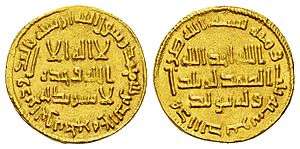 |
Yazid II (يزيد الثاني) |
687 | 10 February 720 | 26 January 724 |
|
|
||
| 15 | 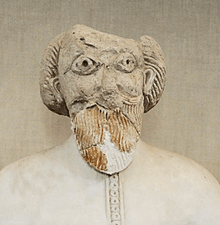 |
Hisham ibn 'Abd al-Malik (هشام بن عبد الملك) |
691 | 26 January 724 | 6 February 743 |
|
|
||
| 16 | _Walid_bin_Yazid.jpg) |
Al-Walid II (الوليد الثاني) |
709 | 6 February 743 | 17 April 744 (assassinated) |
|
|
||
| 17 | Yazid III (يزيد الثالث) |
701 | 17 April 744 | 3/4 October 744 |
|
|
|||
| 18 | Ibrahim ibn al-Walid (ابراهيم ابن الوليد) |
744 (few weeks) | 25 January 750 (executed) |
|
|
||||
| 19 | Marwan II (مروان بن محمد) |
691 | 744 | 6 August 750 (killed) |
|
||||
Abbasid Caliphate (25 January 750 – 20 February 1258)
(Not accepted by the Muslim dominions in the Umayyad-ruled Iberian Peninsula from 756).[2][3]
| # | Image/Coin | Regnal name | Personal name | Born | Reigned from | Reigned until | Died | Parents | Notes |
|---|---|---|---|---|---|---|---|---|---|
| 20 | 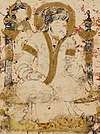 |
As-Sāffaḥ | 'Abdallah Abul-'Abbās | 721 | 750 | 10 June 754 |
|
| |
| 21 | Al-Mansur | Abu Ja'far 'Abdallah | 714 | 10 June 754 | 775 |
|
| ||
| 22 | .jpg) |
Al-Mahdi | Abu 'Abdallah Muhammad | 744/745 | 775 | 4 August 785 |
|
| |
| 23 | Al-Hadi | Abu Muhammad Musa | 764 | August 785 | 14 September 786 |
|
|||
| 24 |  |
Al-Rashid | Harun | 763/766 | 14 September 786 | 24 March 809 |
|
||
| 25 | .jpg) |
Al-Amin | Muhammad | 787 | March 809 | 24/25 September 813 |
|
||
| 26 | Al-Ma'mun | Abu Jaʿfar 'Abdallah | 13/14 September 786 | September 813 | 9 August 833 |
|
|||
| 27 | .jpg) |
Al-Mu'tasim | Abū Ishaq Muhammad | October 796 | 9 August 833 | 5 January 842 |
|
||
| 28 | Al-Wathiq | Abu Ja'far Harun | 811–813 | 5 January 842 | 10 August 847 |
|
|||
| 29 | 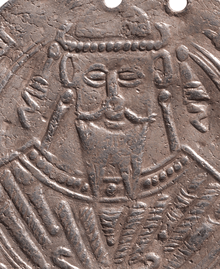 |
Al-Mutawakkil | Ja'far | February/March 822 | 10 August 847 | 11 December 861 (assassinated) |
|
||
| 30 |  |
Al-Muntasir | Abu Ja'far Muhammad | November 837 | 861 | 7 or 8 June 862 |
|
| |
| 31 | 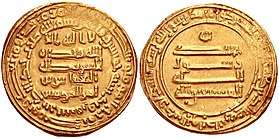 |
Al-Musta'in | Ahmad | 836 | 862 | 866 (executed) |
| ||
| 32 | Al-Mu'tazz | – | 847 | 866 | 869 |
| |||
| 33 | Al-Muhtadi | Abū Isḥāq Muḥammad | 869 | 21 June 870 |
| ||||
| 34 | Al-Mu'tamid | Abu’l-ʿAbbās Aḥmad | 842 | 21 June 870 | 15 October 892 |
|
|||
| 35 | Al-Mu'tadid | Abu'l-'Abbas Ahmad | 854/861 | October 892 | 5 April 902 |
|
| ||
| 36 | Al-Muktafi | Abu Ahmad ʿAlî | 877/878 | 5 April 902 | 13 August 908 |
|
|||
| 37 | Al-Muqtadir | Abu al-Fadl Ja'far | 895 | 13 August 908 | 929 | 31 October 932 (killed) |
|
| |
| 38 | Al-Qahir | Abu Mansur Muhammad | 899 | 929 | 950 |
|
|||
| (37) | Al-Muqtadir | Abu al-Fadl Ja'far | 895 | 929 | 31 October 932 (killed) |
|
| ||
| (38) | Al-Qahir | Abu Mansur Muhammad | 899 | 31 October 932 | 934 | 950 |
|
||
| 39 | Ar-Radi | Abu al-'Abbas Muhammad | December 909 | 934 | 23 December 940 |
|
|||
| 40 | Al-Muttaqi | Abu Ishaq Ibrahim | 908 | 940 | 944 | July 968 |
|
| |
| 41 |  |
Al-Mustakfi | 'Abdallah | 905 | September 944 | January 946 | September/October 949 |
|
|
| 42 | Al-Muti | Abu al-Qasim al-Faḍl | 914 | January 946 | 974 |
|
|||
| 43 | At-Ta'i | – | 932 | 974 | 991 | 3 August 1003 |
|
||
| 44 | 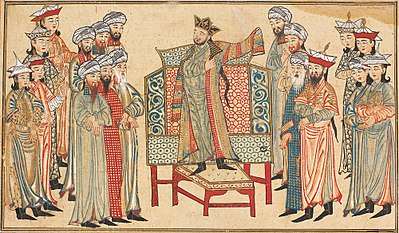 |
Al-Qadir | – | 947 | 1 November 991 | 29 November 1031 |
|
||
| 45 | 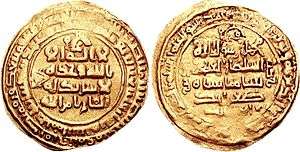 |
Al-Qa'im | – | 1001 | 29 November 1031 | 2 April 1075 |
|
||
| 46 | Al-Muqtadi | – | 1056 | 2 April 1075 | February 1094 |
|
|||
| 47 | Al-Mustazhir | – | April/May 1078 | February 1094 | 6 August 1118 |
|
|||
| 48 | Al-Mustarshid | – | April/May 1092 | 6 August 1118 | 29 August 1135 |
|
|||
| 49 | Ar-Rashid | – | 1109 | 29 August 1135 | 1136 | 6 June 1138 (killed by Hashshashins) |
|
||
| 50 | Al-Muqtafi | – | 9 March 1096 | 1136 | 12 March 1160 |
|
|||
| 51 | Al-Mustanjid | – | 1124 | 12 March 1160 | 20 December 1170 |
|
|||
| 52 | Al-Mustadi | Hassan | 1142 | 20 December 1170 | 30 March 1180 |
|
|||
| 53 | 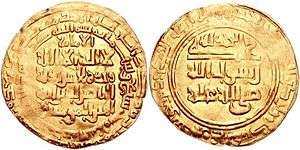 |
An-Nasir | – | 6 August 1158 | 2 March 1180 | 4 October 1225 |
|
||
| 54 | Az-Zahir | – | 1176 | 5 October 1225 | 11 July 1226 |
|
|||
| 55 | Al-Mustansir | Abû Ja`far | 17 February 1192 | 11 July 1226 | 2 December 1242 |
|
|||
| 56 | 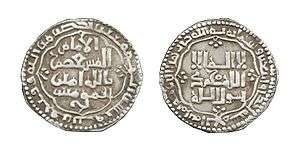 |
Al-Musta'sim | – | 1213 | 2 December 1242 | 20 February 1258 |
|
| |
| Interregnum | |||||||||
During the later period of Abbasid rule, Muslim rulers began using other titles, such as Sultan.
Mamluk Abbasid dynasty (1261 – 1517)
Caliphs of Cairo (13 June 1261 – 22 January 1517)
The Cairo Abbasids were largely ceremonial Caliphs under the patronage of the Mamluk Sultanate that existed after the takeover of the Ayyubid dynasty.[6][7]
| # | Regnal name | Personal name | Reign | Parents | Notes |
|---|---|---|---|---|---|
| 57 | Al-Mustansir | Abu al-Qasim Ahmad | 13 June 1261 – 28 November 1261 |
| |
| 58 | Al-Hakim I | Abu 'Abdullah Muhammad | 16 November 1262 – 19 January 1302 |
|
|
| 59 | Al-Mustakfi I | Abu ar-Rabi' Sulaiman | 20 January 1302 – February 1340 |
|
|
| 60 | Al-Wathiq I | Abu Ishaq Ibrahim | February 1340 – 17 June 1341 |
|
|
| 61 | Al-Hakim II | Abu al-'Abbas Ahmad | 1341 – 1352 |
|
|
| 62 | Al-Mu'tadid I | Abu Bakr | 1352 – 1362 |
|
|
| 63 | Al-Mutawakkil I | Abu 'Abdillah Muhammad | 1362 – 1377 | ||
| 64 | Al-Mus'tasim | Abu Yahya Zakariya | 1377 | ||
| (63) | Al-Mutawakkil I | Abu 'Abdillah Muhammad | 1377 – 1383 | ||
| 65 | Al-Wathiq II | 'Umar | September 1383 – 13 November 1386 | ||
| (64) | Al-Mus'tasim | Abu Yahya Zakariya | 1386 – 1389 | ||
| (63) | Al-Mutawakkil I | Abu 'Abdillah Muhammad | 1389 – 9 January 1406 | ||
| 66 | Al-Musta'in | Abu al-Fadl al-'Abbas | 22 January 1406 – 9 March 1414 |
|
|
| 67 | Al-Mu'tadid II | Abu al-Fath Dawud | 1414 – 1441 |
|
|
| 68 | Al-Mustakfi II | Abu ar-Rabi' Sulayman | 1441 – 29 January 1451 | ||
| 69 | Al-Qa'im | Abu Al-Baqa Hamzah | 1451 – 1455 | ||
| 70 | Al-Mustanjid | Abu al-Mahasin Yusuf | 1455 – 7 April 1479 | ||
| 71 | Al-Mutawakkil II | Abu al-'Izz 'Abdul 'Aziz | 5 April 1479 – 27 September 1497 |
|
|
| 72 | Al-Mustamsik | Abu as-Sabr | 1497 – 1508 | ||
| 73 | Al-Mutawakkil III | Muhammad | 1508 – 1516 | ||
| (72) | Al-Mustamsik | Abu as-Sabr | 1516 – 1517 | ||
| (73) | Al-Mutawakkil III | Muhammad | 1517 |
|
Ottoman Caliphate (1517 – 3 March 1924)
The head of the Ottoman dynasty was just entitled Sultan originally, but soon it started accumulating titles assumed from subjected peoples.[8][9] Murad I (reigned 1362–1389) was the first Ottoman claimant to the title of Caliph; claimed the title after conquering Edirne.[10]
| # | Portrait | Tughra | Name | Reign | Parents | Notes |
|---|---|---|---|---|---|---|
| 74 |  |
Selim I | 1517 – 21 September 1520 |
| ||
| 75 | 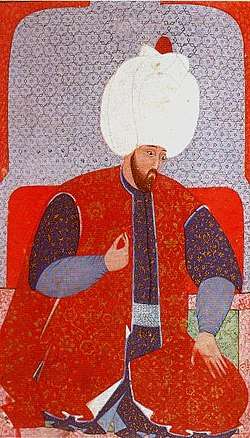 |
 |
Suleiman I | 30 September 1520 – 6 or 7 September 1566 |
|
|
| 76 | 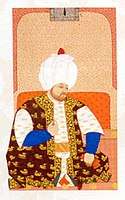 |
Selim II | 29 September 1566 – 21 December 1574 |
|
| |
| 77 | 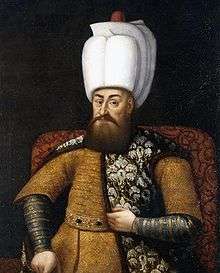 |
Murad III | 22 December 1574 – 16 January 1595 |
|
| |
| 78 | _Enthroned%2C_Attended_by_Two_Janissaries_LACMA_M.85.237.34.jpg) |
Mehmed III | 27 January 1595 – 20 or 21 December 1603 |
|
| |
| 79 | 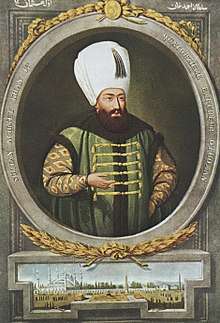 |
Ahmed I | 21 December 1603 – 22 November 1617 |
|
| |
| 80 | .jpg) |
Mustafa I | 22 November 1617 – 26 February 1618 |
| ||
| 81 | Osman II | 26 February 1618 – 19 May 1622 |
|
|||
| (80) | .jpg) |
Mustafa I | 20 May 1622 – 10 September 1623 |
| ||
| 82 | 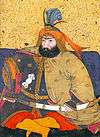 |
Murad IV | 10 September 1623 – 8 or 9 February 1640 |
|
| |
| 83 | 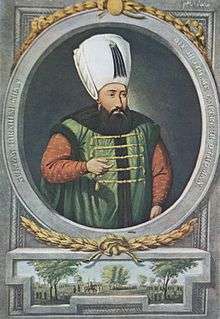 |
Ibrahim | 9 February 1640 – 8 August 1648 | |||
| 84 | 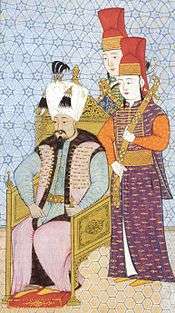 |
Mehmed IV | 8 August 1648 – 8 November 1687 |
|
| |
| 85 |  |
Suleiman II | 8 November 1687 – 22 June 1691 |
|
| |
| 86 | 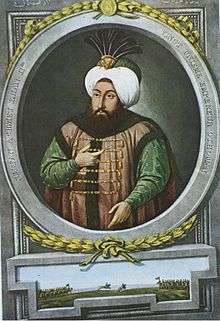 |
Ahmed II | 22 June 1691 – 6 February 1695 |
|
| |
| 87 | 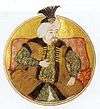 |
Mustafa II | 6 February 1695 – 22 August 1703 |
|
| |
| 88 | 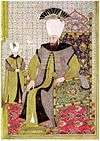 |
Ahmed III | 22 August 1703 – 1 or 2 October 1730 |
|
| |
| 89 | 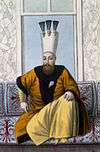 |
Mahmud I | 2 October 1730 – 13 December 1754 |
|
| |
| 90 | 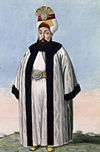 |
Osman III | 13 December 1754 – 29 or 30 October 1757 |
|
| |
| 91 |  |
Mustafa III | 30 October 1757 – 21 January 1774 |
|
| |
| 92 | 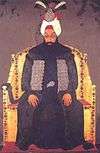 |
Abdul Hamid I | 21 January 1774 – 6 or 7 April 1789 |
|
| |
| 93 | 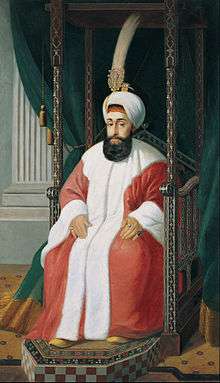 |
Selim III | 7 April 1789 – 29 May 1807 |
|
| |
| 94 | 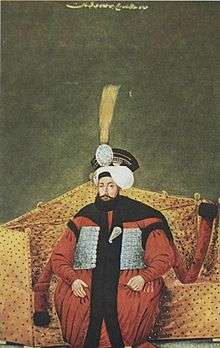 |
Mustafa IV | 29 May 1807 – 28 July 1808 |
|
| |
| 95 | 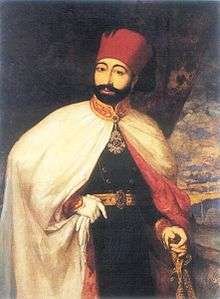 |
Mahmud II | 28 July 1808 – 1 July 1839 |
|
| |
| 96 |  |
Abdulmejid I | 1 July 1839 – 25 June 1861 |
|
| |
| 97 |  |
Abdulaziz | 25 June 1861 – 30 May 1876 |
|
| |
| 98 |  |
Murad V | 30 May 1876 – 31 August 1876 |
|
| |
| 99 | 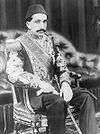 |
 |
Abdul Hamid II | 31 August 1876 – 27 April 1909 |
|
|
| 100 | 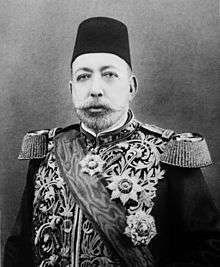 |
 |
Mehmed V | 27 April 1909 – 3 July 1918 |
|
|
| 101 | 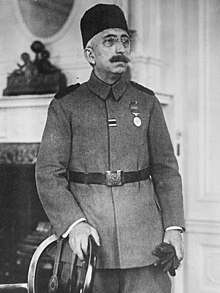 |
 |
Mehmed VI | 4 July 1918 – 1 November 1922 |
|
|
| 102 |  |
— [c] |
Abdulmejid II | 18 November 1922 – 3 March 1924 |
|
|
The Office of the Ottoman Caliphate was transferred to the Grand National Assembly of Turkey which dissolved the office on March 3, 1924, in keeping with the policies of secularism that were adopted in the early years of the Republic of Turkey by its President Mustafa Kemal Atatürk.
After the abolition of the Caliphate, the Grand National Assembly of Turkey founded the Presidency of Religious Affairs as the new highest Islamic religious authority in the country.
Non-ecumenical caliphates
Caliphates not accepted as legitimate by the majority of Muslims.
Ibn al-Zubayr's Caliphate (684–692)
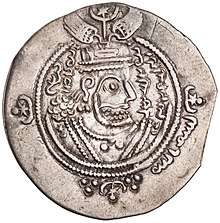
Abd Allah ibn al-Zubayr, the nephew of Aisha, the third wife of Muhammad led a rebellion against the Umayyad Caliphate in 684 AD. He was proclaimed caliph in Mecca but was defeated and killed there in 692 AD after a six-month siege by general Al-Hajjaj ibn Yusuf.[42]
Ummayad Caliphate of Córdoba (929–1031)
(Not universally accepted; actual authority confined to Spain and parts of Maghreb)[43][44]
| Name | Reign | Parents | Notes |
|---|---|---|---|
| Abd-ar-Rahman III | 929–961 |
|
|
| Al-Hakam II | 961–976 |
|
|
| Hisham II al-Hakam | 976–1009 | ||
| Muhammad II | 1009 |
|
|
| Sulayman ibn al-Hakam | 1009–1010 |
|
|
| Hisham II al-Hakam | 1010–1013 | ||
| Sulayman ibn al-Hakam | 1013–1016 |
|
|
| Abd ar-Rahman IV | 1021–1022 |
|
|
| Abd ar-Rahman V | 1022–1023 |
|
|
| Muhammad III | 1023–1024 |
|
|
| Hisham III | 1027–1031 |
|
Fatimid Caliphate (909–1171)
(The Fatimids were Isma'ili Shia who claimed to be descendants of Muhammad's daughter Fatimah and were seen as heretics by Sunnis. Their claims to a caliphate are also not recognized by the Muslim Ummah as a legitimate successor of the title of Caliph passed down from Muhammad , as no legitimate proof existed they were descendant from Fatimah).[45][46]
| Name | Reign | Parents | Notes |
|---|---|---|---|
| Al-Mahdi Billah | 909–934 |
|
|
| Al-Qa'im Bi-Amrillah | 934–946 |
|
|
| Al-Mansur Billah | 946–953 | ||
| Al-Muizz Lideenillah | 953–975 | Egypt is conquered during his reign | |
| Al-Aziz Billah | 975–996 | ||
| Al-Hakim bi-Amr Allah | 996–1021 | ||
| Ali az-Zahir | 1021–1036 | ||
| Al-Mustansir Billah | 1036–1094 | ||
| Al-Musta'li | 1094–1101 | Quarrels over his succession led to the Nizari split | |
| Al-Amir | 1101–1130 | The Fatimid rulers of Egypt after him are not recognized as Imams by Mustaali Taiyabi Isma'ilis | |
| Al-Hafiz | 1130–1149 |
|
|
| Al-Zafir | 1149–1154 | ||
| Al-Faiz | 1154–1160 | ||
| Al-Azid | 1160–1171 |
|
Almohad Caliphate (1145–1269)

(Not widely accepted, actual dominions were parts of North Africa and Iberia)[47][48]
| Name | Reign | Notes |
|---|---|---|
| Abd al-Mu'min | 1145–1163 | |
| Abu Yaqub Yusuf I | 1163–1184 | |
| Yaqub al-Mansur | 1184–1199 | |
| Muhammad an-Nasir | 1199–1213 | |
| Abu Ya'qub Yusuf II | 1213–1224 | |
| Abd al-Wahid I | 1224 | |
| Abdallah al-Adil | 1224–1227 | |
| Yahya | 1227–1235 | |
| Idris I | 1227–1232 | |
| Abdul-Wahid II | 1232–1242 | |
| Ali | 1242–1248 | |
| Umar | 1248–1266 | |
| Idris II | 1266–1269 |
Indian caliphates
Since the 12th century, despite the South Asian domination of numerous Muslim empires, kingdoms and sultanates, Islamic caliphates were not fully attempted to be established across the Indian subcontinent. However, under the sharia based reigns of Sunni emperors such as Alauddin Khalji, Mughal Empire's Aurangzeb, and Mysore's rulers Hyder Ali and Tipu Sultan, absolute forms of caliphates were clearly to have appeared. These largely impacted the French-Italian emperor Napoleone Bonaparte and soldiers of the British Empire.[49][50][51][52]
Sokoto Caliphate (1804–1903)
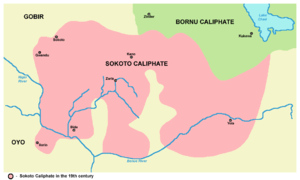
(Not widely accepted, actual dominions were parts of West Africa)
Established by Tariqa Islamic scholar and religious leader Usman dan Fodio through the Fulani War (alternatively known as the Fulani Jihad), which sought to reduce the influence of pre-Islamic religious practices and spread a more vigorous form of Islam through the auspices of a Caliphate.
Bornu and Songhai Empires

Several rulers of West Africa adopted the title of Caliph. Mai Ali Ghaji ibn Dunama was the first ruler of Bornu Empire to assume the title. Askia Mohammad I of Songhai Empire also assumed the title around the same time.[53]
Non-ecumenical caliphates declared after 1900
Since the dissolution of the Ottoman Empire, there has been no single recognized, "ecumenical" caliphate.
Sharifian Caliphate (1924–1925)

A last attempt at restoring the caliphal office and style with ecumenical recognition was made by Hussein bin Ali, King of Hejaz and Sharif of Mecca, who assumed both on 11 March 1924 and held them until 3 October 1924, when he passed the kingship to his son `Ali ibn al-Husayn al-Hashimi, who did not adopt the caliphal office and style.[54] Hussein's claim for caliphate was not accepted however, and in 1925 he was driven from Hejaz by the forces of Ibn Saud due to his lack of support for Shari'ah. He continued to use the title of caliph during his remaining life in exile, until his death in 1931. Like the Fatimid caliphs, he was a descendant of Muhammad through a grandson of Hasan ibn Ali.
The Return of The Islamic Caliphate (2014–present)
On 29 June 2014, the Islamic State declared the return of the islamic caliphate and its first caliph was Amirul-mu'minin Abu Bakr Ibrahim bin Awwad Al-Badri Al-Husaini Al-Hashimi Al-Quraishi As-sammera'i al-Baghdadi[55][56] and the caliphate contained more than 12-million-people territory in Wilayat Al-'iraq and Wilyat Ash-sham and Alot more in Wilayat gharb Ifriqiyyah(the state of West Africa) and Wilayat Sharq Asia(The State of North Asia) and Wilayat Khorasan and Wilayat wasat Ifriqiyyah(The State of Central of Africa) and Wilayat Al-Yaman(The State of Yemen) and Wilayat Sina'(The State of Sinai)[57] under control of Islamic State.[58]
On 7 March 2015, Abu-bakr Al-Shekau pledged allegiance to The Islamic State via an official audio message[59][60] Afterwards, Boko Haram assumed the name "Wilāyat Gharb Ifriqiyyah" (Arabic: ولاية غرب إفريقية, "West Africa Province") or "Islamic State of West Africa" (ISWAP).[61]
However, on the 10th of April, 2018, during a rally headlined by U.S. President Donald Trump in support of Mike Braun’s bid for the US Senate in Elkhart, Indiana, Vice President Mike Pence referred to ISIS as a Caliphate, claiming “ISIS is on the run, their Caliphate has crumbled, and we will soon drive them out of existence once and for all."[62]
| # | Caliph | Date of birth | Reigned From | Reigned until |
|---|---|---|---|---|
| 1 | Abu-Bakr Ibrahim bin Awwad bin Ibrahim bin Ali bin Muhammad Al-Badri Al-Husaini Al-Hashimi Al-Quraishi As-sammera'i al-Baghdadi | 28 July 1971 | 29 June 2014 | 27 October 2019 |
| 2 | Abu-Ibrahim Al-Hashimi Al-Quraishi | October 1976 | 31 October 2019 | Present |
 Islamic Caliphate's Flag Called "Al-'okab" (Black Standard).
Islamic Caliphate's Flag Called "Al-'okab" (Black Standard).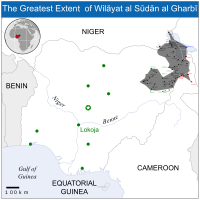 The greatest extent of Wilāyat Gharb Ifriqiyyah(in January 2015)
The greatest extent of Wilāyat Gharb Ifriqiyyah(in January 2015)_Territory_Change_2014-2016.gif) The Islamic Caliphate Territory in The two States of Iraq and Levent
The Islamic Caliphate Territory in The two States of Iraq and Levent
Non-political
Ahmadiyya Caliphate (1908–present)[nb 1]

Khalīfatul Masīh (Arabic: خليفة المسيح; Urdu: خلیفہ المسیح; English: Successor of the Messiah) or Khalifa of Ahmadiya Community [66] sometimes simply referred to as Khalifah (i.e. Caliph, successor) is the elected spiritual and organizational leader of the worldwide Ahmadiyya Community and is the successor of Mirza Ghulam Ahmad of Qadian who had claimed to be the Mahdi and Messiah in their community. The Caliph is believed to be divinely guided and is also referred to by members of the Ahmadiyya Community as Amir al-Mu'minin (Leader of the Faithful). The fifth and current Khalifatul Masih is Mirza Masroor Ahmad. The first caliph was in 34th direct lineal male descent of Caliph Umar Ibn al-Khattab; the second caliph was in 41th direct lineal male descent of Husayn ibn Ali and thus his followers.
After the death of Ghulam Ahmad, his successors directed the Ahmadiyya Community from Qadian which remained the headquarters of the community until 1947 with the creation of Pakistan. From this time on the headquarters remained in Rabwah, a town built on land bought in Pakistan by the community in 1948. In 1984, Ordinance XX was promulgated by the government of Pakistan which rendered the Khalifatul Masih unable to perform his duties and put the very institution in jeopardy. Due to these circumstances, Khalifatul Masih IV left Pakistan and migrated to London, England, provisionally moving the headquarters to the Fazl Mosque.[67]
See also
- Worldwide caliphate
- Shah
- Emir
- Shaykh al-Islām
- Grand Imam of al-Azhar
- List of Grand Imams of al-Azhar
- List of Presidents of Al-Azhar University
- Mouride#Leadership
- Succession to Muhammad
- History of Islam
- Shi'a Islam
- Sunni Islam
- Sharifate of Mecca
Notes
References
- "Imam Hassan as". Duas.org.
- Lane-Poole 2004, pp. 12–13
- Bosworth 2004, pp. 6–7
- Al-Mudaffar, Sheikh Muhammad Al-Hussein. Imam Jafar Sadiq. p. 291.
- ibn Maja (1368). al-Sunan, II.
- Bosworth 2004, p. 7
- Houtsma & Wensinck 1993, p. 3
- Lane-Poole 2004, p. 195
- Bosworth 2004, pp. 239–240
- Lambton, Ann; Lewis, Bernard (1995). The Cambridge History of Islam: The Indian sub-continent, South-East Asia, Africa and the Muslim west. 2. Cambridge University Press. p. 320. ISBN 9780521223102. Retrieved 14 March 2015.
- "Yavuz Sultan Selim Han". Republic of Turkey Ministry of Culture and Tourism. Retrieved 2009-02-06.
- "Kanuni Sultan Süleyman Han". Republic of Turkey Ministry of Culture and Tourism. Retrieved 2009-02-06.
- "Sultan II. Selim Han". Republic of Turkey Ministry of Culture and Tourism. Retrieved 2009-02-06.
- "Sultan III. Murad Han". Republic of Turkey Ministry of Culture and Tourism. Retrieved 2009-02-06.
- "Sultan III. Mehmed Han". Republic of Turkey Ministry of Culture and Tourism. Retrieved 2009-02-06.
- "Sultan I. Ahmed". Republic of Turkey Ministry of Culture and Tourism. Retrieved 2009-02-06.
- "Sultan I. Mustafa". Republic of Turkey Ministry of Culture and Tourism. Retrieved 2009-02-06.
- "Sultan II. Osman Han". Republic of Turkey Ministry of Culture and Tourism. Retrieved 2009-02-06.
- "Sultan IV. Murad Han". Republic of Turkey Ministry of Culture and Tourism. Retrieved 2009-02-06.
- "Sultan İbrahim Han". Republic of Turkey Ministry of Culture and Tourism. Retrieved 2009-02-06.
- "Sultan IV. Mehmed". Republic of Turkey Ministry of Culture and Tourism. Retrieved 2009-02-06.
- "Sultan II. Süleyman Han". Republic of Turkey Ministry of Culture and Tourism. Retrieved 2009-02-06.
- "Sultan II. Ahmed Han". Republic of Turkey Ministry of Culture and Tourism. Retrieved 2009-02-06.
- "Sultan II. Mustafa Han". Republic of Turkey Ministry of Culture and Tourism. Retrieved 2009-02-06.
- "Sultan III. Ahmed Han". Republic of Turkey Ministry of Culture and Tourism. Retrieved 2009-02-06.
- "Sultan I. Mahmud Han". Republic of Turkey Ministry of Culture and Tourism. Retrieved 2009-02-06.
- "Sultan III. Osman Han". Republic of Turkey Ministry of Culture and Tourism. Retrieved 2009-02-06.
- "Sultan III. Mustafa Han". Republic of Turkey Ministry of Culture and Tourism. Retrieved 2009-02-06.
- "Sultan I. Abdülhamit Han". Republic of Turkey Ministry of Culture and Tourism. Retrieved 2009-02-06.
- "Sultan III. Selim Han". Republic of Turkey Ministry of Culture and Tourism. Retrieved 2009-02-06.
- "Sultan IV. Mustafa Han". Republic of Turkey Ministry of Culture and Tourism. Retrieved 2009-02-06.
- "Sultan II. Mahmud Han". Republic of Turkey Ministry of Culture and Tourism. Retrieved 2009-02-06.
- "Sultan Abdülmecid Han". Republic of Turkey Ministry of Culture and Tourism. Retrieved 2009-02-06.
- "Sultan Abdülaziz Han". Republic of Turkey Ministry of Culture and Tourism. Retrieved 2009-02-06.
- "Sultan V. Murad Han". Republic of Turkey Ministry of Culture and Tourism. Retrieved 2009-02-06.
- "Sultan II. Abdülhamid Han". Republic of Turkey Ministry of Culture and Tourism. Retrieved 2009-02-06.
- "Sultan V. Mehmed Reşad Han". Republic of Turkey Ministry of Culture and Tourism. Retrieved 2009-02-06.
- "Sultan VI. Mehmed Vahdettin Han". Republic of Turkey Ministry of Culture and Tourism. Retrieved 2009-02-06.
- As̜iroğlu 1992, p. 13
- As̜iroğlu 1992, p. 17
- As̜iroğlu 1992, p. 14
- Dictionary of Battles and Sieges: F-O edited by Tony Jacques
- Lane-Poole 2004, p. 21
- Bosworth 2004, p. 11
- Lane-Poole 2004, p. 71
- Bosworth 2004, p. 63
- Lane-Poole 2004, p. 47
- Bosworth 2004, p. 39
- Jackson, Roy (2010). Mawlana Mawdudi and Political Islam: Authority and the Islamic State. Routledge. ISBN 9781136950360.
- Shah Muhammad Waseem (2003): هندوستان ميں فارسى تاريخ نگارى: ٧١ويں صدى كے آخرى نصف سے ٨١ويں صدى كے پهلے نصف تک فارسى تاريخ نگارى كا ارتقاء, Kanishka Publishing, original source from the University of Michigan ISBN 9788173915376
- Hussein, S M (2002). Structure of Politics Under Aurangzeb 1658-1707. Kanishka Publishers Distributors (2002). ISBN 978-8173914898.
- Banarsi Prasad Saksena (1992) [1970]. "The Khaljis: Alauddin Khalji". In Mohammad Habib and Khaliq Ahmad Nizami (ed.). A Comprehensive History of India: The Delhi Sultanat (A.D. 1206–1526). 5 (Second ed.). The Indian History Congress / People's Publishing House. OCLC 31870180.CS1 maint: ref=harv (link)
- Nehemia Levtzion; Randall Pouwels. The History of Islam in Africa. Ohio University Press. p. 81.
- Bosworth 2004, p. 118
- Adam Withnall (2014-06-30). "Iraq crisis: Isis declares its territories a new Islamic state with 'restoration of caliphate' in Middle East - Middle East - World". The Independent. Retrieved 2014-07-04.
- "ISIS Spokesman Declares Caliphate, Rebrands Group as "Islamic State"". SITE Institute. 29 June 2014. Retrieved 29 June 2014.
- "Islamic State-controlled parts of Syria, Iraq largely out of reach: Red Cross". 13 March 2015 – via Reuters.
- Yusuf al-Qaradawi stated: "[The] declaration issued by the Islamic State is void under sharia and has dangerous consequences for the Sunnis in Iraq and for the revolt in Syria", adding that the title of caliph can "only be given by the entire Muslim nation", not by a single group. Strange, Hannah (5 July 2014). "Islamic State leader Abu Bakr al-Baghdadi addresses Muslims in Mosul". The Telegraph. Retrieved 6 July 2014.
- "Nigeria's Boko Haram pledges allegiance to Islamic State". BBC news. BBC. 2015-03-07. Retrieved 2015-03-07.
- Adam Chandler (March 9, 2015). "The Islamic State of Boko Haram? :The terrorist group has pledged its allegiance to ISIS. But what does that really mean?". The Atlantic.
- "Africa blog: Islamic State strengthens ties with Boko Haram". BBC News. Retrieved 25 April 2015.
- Trump TV Network (2018-05-10), FULL EVENT: President Donald Trump MASSIVE Rally in Elkhart, Indiana - May 10, 2018, retrieved 2018-05-12. See 6:00
- "Ahmadis - Oxford Islamic Studies Online". www.oxfordislamicstudies.com. Retrieved 2018-09-03.
Controversial messianic movement founded by Mirza Ghulam Ahmad in Qadian, Punjab (British-controlled India), in 1889. Founder claimed to be a “nonlegislating” prophet (thus not in opposition to the mainstream belief in the finality of Muhammad 's “legislative” prophecy) with a divine mandate for the revival and renewal of Islam ...
- "The Ahmadiyyah Movement - Islamic Studies - Oxford Bibliographies - obo". Retrieved 2018-09-03.
- "Ghulam Ahmad, Mirza - Oxford Islamic Studies Online". www.oxfordislamicstudies.com. Retrieved 2018-09-08.
Founder of Ahmadi movement in Punjab, India, in 1889... The movement is labeled non-Muslim and fiercely opposed by Muslims, although the group considers itself Muslim.
- http://www.caliphofislam.com Archived 2014-12-19 at the Wayback Machine
- "Khilafat - Caliphate - The Guided Khilafat - Khilafat e Ahmadiyya - Al Islam Online". www.alislam.org.
Bibliography
- Bosworth, Clifford Edmund (2004) [1996]. The New Islamic Dynasties: A Chronological and Genealogical Manual. New Edinburgh Islamic Surveys (2nd ed.). Edinburgh University Press. ISBN 978-0-7486-2137-8. OCLC 56639413.
- Houtsma, M. Th.; Wensinck, A. J. (1993). E.J. Brill's First Encyclopaedia of Islam 1913–1936 (Reprint)
|format=requires|url=(help). Volume IX. Leiden: BRILL. ISBN 978-90-04-09796-4. - Lane-Poole, Stanley (1894). The Mohammedan Dynasties: Chronological and Genealogical Tables with Historical Introductions. Westminster: Archibald Constable and Company. OCLC 1199708.
